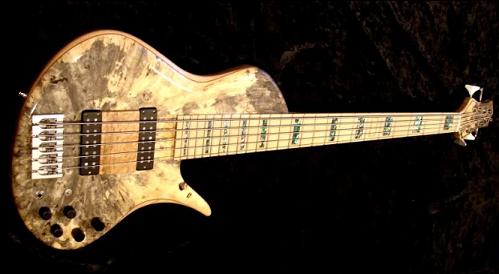Pierre Erizias: Building the Best Boutique Bass
(ShackMan | Posted 2010-07-14)

How many times have we as bass players marveled at a $5,000, $8,000, or even $10,000 price tag? How many times after that have we finally managed to play the bass after salivating in front of online pictures and lamenting the size of our pocketbooks only to find that the object of our desire might not be the greatest thing since the roundwound string? There's a fundamental element that's so often missing in these high-end boutique basses with boutique prices and diamond encrusted knobs and frets with all the bells and whistles. Sure, they're dreams to behold, but are they just as much of a dream when I'm holding them? Canadian bass maker Pierre Erizias is one of the (sadly) very few bass makers who understand this plight.
And why might that be? He's a bass player. Imagine that.
"Nah, you play it. I'm so rusty, I'm sure you'd sound better than me," a very modest Erizias was heard to say from his barely-bigger-than-a-closet booth at this year's Summer NAMM show. Even "rusty," (his word, not mine) his chops are still formidable, and I was a bit nervous when he handed me the acoustic fretless I had pointed out. When I got the bass settled and the strap adjusted to my small stature, jitters settled into an ease brought on by the sheer simplicity and near-perfect ergonomic design of the bass. It’s 5 strings felt like they were just barely off the fretboard under my left hand, and the neck’s contour alone spoke volumes about comfort and ease of motion when playing a bass. The tone was bright enough to know it was an electric fretless, a feature this writer has found lacking in boutique basses (Frankly, if I want to sound like an upright bass, I’ll play one) but still had the warm “Mmwah” of fully rounded fretless tone.

Plucking over the neck, the strings felt as though they were higher than my left seemed to think, enough to facilitate a little digging in without fear of buzz or overplaying, the results of a well-tuned and set-up bass. Given the smooth sounds I was getting over the neck, I was amazed at the stark contrast and brightness I found when I moved my hand over the bridge. As impressed as I was, it still came as a surprise to me that he was able to work the same setup magic on his fretted basses as well.
In the 16 years since building his first electric bass, Pierre Erizias has only realized all the more the secret to building great instruments, one which really isn’t a secret at all. “I build basses that I would want to play,” he says. “It’s not done until it feels perfect.” And that’s exactly the result he’s getting. Try as I might, I could not find a fault with Erizias’ basses at the booth in tone, balance, or design. They played far better than their roughly $2,000-$4,000 price range belied, and that kind of freedom is the reason that players drop that kind of money. If you haven’t heard of him, you as a bass player owe it to yourself to check out Erizias’ basses as soon as possible. Pierre Erizias is, without a doubt, among the best of the boutique bass builders today.
Pierre's instruments can be found at www.eriziasbasses.com. You may contact him with any questions or to ask about a custom bass for yourself at info@eriziasbasses.com.
James Rushin is a bassist, keyboardist, writer, and composer living and working in the Greater Pittsburgh area. He has performed with Selmer artist Tim Price, Curtis Johnson, guitarists Ken Karsh and Joe Negri, and his compositions have been featured at West Virginia University and Valley Forge Christian College. His contest winning essays and short stories have seen publication in and around the Tri-State area.
Feel free to e-mail James with comments, questions, concerns, at james.rushin@musicgearreview.com.




